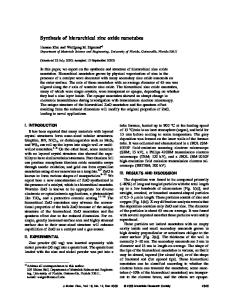Solvothermal Routes for Synthesis of Zinc Oxide Nanorods
- PDF / 632,398 Bytes
- 11 Pages / 612 x 792 pts (letter) Page_size
- 48 Downloads / 488 Views
Y2.6.1
Solvothermal Routes for Synthesis of Zinc Oxide Nanorods Nelson S. Bell Sandia National Laboratories P.O. Box 5800-1411 Albuquerque, NM 87185 ABSTRACT Control of the synthesis of nanomaterials to produce morphologies exhibiting quantized properties will enable device integration of several novel applications including biosensors, catalysis, and optical devices. In this work, solvothermal routes to produce zinc oxide nanorods are explored. Much previous work has relied on the addition of growth directing/inhibiting agents to control morphology. It was found in coarsening studies that zinc oxide nanodots will ripen to nanorod morphologies at temperatures of 90 to 120 °C. The resulting nanorods have widths of 9-12 nm average dimension, which is smaller than current methods for nanorod synthesis. Use of nanodots as nuclei may be an approach that will allow for controlled growth of higher aspect ratio nanorods. INTRODUCTION The production of nanomaterials of controlled size and shape has been touted as a route to improved or novel devices and components1. Zinc oxide is an interesting material candidate for synthesis as it has demonstrated interesting optical properties such as ultraviolet lasing2, as well as application as a gas sensor. Zinc oxide studies have been conducted for several decades, and shown chemical properties dependant on synthesis method or sample history3. In fact, Zn(OH)2 is metastable to ZnO, but the free energy difference is small, and it is relatively easy to form ZnO at room temperature via solution routes. Much of the study of shape control and the synthesis of nanorods have focused on the CdS and CdSe systems. Both zinc oxide and CdS/CdSe have the wurtzite crystal structure, and the observations gained in these systems will likely aid studies with ZnO. Alivisatos and co-workers have described a route to producing nanorods based on a chemical synthesis strategy4,,5,,6: 1. Utilize the inherent crystal structure as a growth directing agent. 2. Perform synthesis using a surfactant mixture that is dynamically adsorbed, so that the surfactants regulate the growth rate of different faces. The surfactant also provides colloidal stability, regulates interparticle separation, and using bulkier or higher molecular weight surfactants can modify the rate of monomer addition to nuclei. 3. Control nucleation by rapid injection of the precursor. 4. At least one surfactant must promote monomer exchange between particles to realize condition of “size distribution focusing” so that monodisperse particles are produced. The shape evolution of nanoparticle of CdSe have been studied by Peng and Peng7. The monomer concentration was critical to forming nanorods, as a high monomer concentration promoted rod formation, whereas lower concentrations gave equiaxed
Y2.6.2
particles or allowed particles to perform “1D-to-2D ripening” where the aspect ratio decreased. The ligands used to solubilize Cd were critical to control of monomer concentration and growth rate, leading to shape control. Strong ligands with the c
Data Loading...










